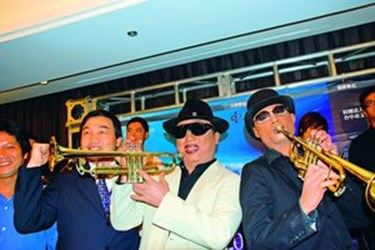The reputation of Taiwan's original City of Culture suffered in the mid-20th century, but Taichung is once again asserting itself as the nation's cultural heartland.
BY JACQUES VAN WERSCH
PHOTOS BY DONALD SILVER
Sitting on the 46th floor of Taichung's newest luxury hotel, the mayor shifted his gaze from the city below him momentarily, lowering his head and putting his hand to his brow, as ICRT DJ Rick Monday asked him about his attempt to attract the Guggenheim Museum to Taichung. "Oh, Ricky," he groaned. "Why do you have to bring up my biggest failure like this on national radio?" Jason Hu was guest-hosting the English-language radio station's Taichung Week, which was being broadcast on location from Hotel One, and he was his usual charismatic self. "I hate to call it a failure, but it was," Hu continued. "Still, if it weren't for our unsuccessful attempt to lure the Guggenheim to Taichung, we would not have attracted such a strong field of architects vying to build our [Taichung Metropolitan] Opera House. Seven of the competitors were Pritzker laureates. If it weren't for the Guggenheim, they would never even have heard of Taichung," he said, referring to the Pritzker Architecture Prize, which is often described as the Nobel Prize for architecture.
Hu's bid to bring a Guggenheim branch museum to Taichung was big news in Taiwan in 2004, and it certainly made waves in global architecture circles; a site and a futuristic design by Zaha Hadid, the first female Pritzker laureate, had already been selected. After signing a memorandum of understanding with New York's Solomon R. Guggenheim Foundation, however, Taichung eventually had to scupper the plan because the central government could not allocate the required funding.
The mayor had been trying to make good on a 2001 campaign promise to develop Taiwan's central city into a cultural hub. While campaigning, Hu warned voters that after Taiwan's provincial government, located near Taichung, was "frozen" in 1998, central Taiwan no longer had a competitive edge against its bigger northern and southern neighbors. Taichung did not have a massive deepwater port and heavy-industry infrastructure like Kaohsiung in the south or the definitive political and economic clout of the capital, Taipei, in the north. Truth be told, neither did it have an impressive platform from which to launch itself as Taiwan's cultural capital. That being the case, Hu took on the task of building the platform.
City of Culture
Asked about the basis for Taichung as a cultural city, Mark Huang, the director of the city's Cultural Affairs Bureau, says it was in fact known as the City of Culture (wenhua cheng) when the Taiwan Cultural Association (est. 1921) was moved there from Taipei in 1927 because most of its members were from central Taiwan. The association is remembered with reverence not only for its efforts to promote cultural activities, but also--and especially--for its dissemination of Taiwanese nationalistic values during the Japanese colonial period.
Huang says that back in the 1920s, it made sense to locate such organizations in Taichung because for members it meant less cumulative travel along the island's then tortuous roads to attend meetings. Huang admits, however, that by the middle of the 20th century, Taichung was much better known by a more colorful title: City of Vice (fenghua cheng). "Traditionally, Taichung City is at the heart of six areas, including Taichung County, Nantou County, Changhua County, Yunlin County and Miaoli County. For all these places, Taichung City is the consumer center. So as the economy boomed, people came to Taichung City for all kinds of things, and this includes what we call the 'special businesses,'" Huang says. "Special businesses" is a Mandarin euphemism for the sex industry, gambling and other bawdy entertainment. Huang says that since Hu took measures to eliminate the illegal sex trade--including hostess bars and other fronts for prostitution--while promoting visual and performing arts, the tide has turned.
"Since we began organizing so many cultural events, people have increased their inclination to participate. So we've reduced participation in one type of activity and increased participation in another. When I meet with officials from other cities, they all say, 'You're doing such a great job with culture,' and you know, they really envy us," Huang says. "At the [2007 Taichung] Jazz Festival, as Mayor Hu was making his way to listen to the performance, people were lining up to shake his hand and thanking him for making possible such great events these past few years."
Jazzing up Taichung
Mayor Hu is a culture lover with a special fondness for jazz. His love for the genre gave impetus to the Taichung Jazz Festival, the only jazz festival in Taiwan. In last October's fifth annual edition, the main outdoor stage was set up at People's Park, at the heart of the city's new downtown, near Hotel One. Featured international musicians included saxophonist Eric Marienthal, singer Flora Purim and trumpet virtuoso Wallace Roney. The festival's program is a mix of international jazz royalty, local ensembles and foreign nationals who have cut their chops in Taiwan. Canada-born, Taichung-based saxophonist Patrick Byrne describes his appearance on the main stage at the 2006 festival as a highpoint in his performance career. "I was playing up on stage and staring at my image on this huge screen with 2,000 people looking on, and I thought maybe it was a better idea to just concentrate on the sax," he recalls. In 2007, Byrne appeared with his band Money Shot Horns on one of the festival's satellite stages. Byrne, who has helped the event's organizers to book acts over the years, sees the event as a work in progress and hopes eventually "some of the international acts can move from the festival itself to smaller venues around town." He says this would change the performer-audience dynamic. "Suddenly it's more up close and personal, more intimate--and that will enhance people's appreciation of the festival and also of music in general," he says.
Byrne is one of many foreigners who have made Taichung their home. A combination of factors attract them, not least of which is the climate. Taichung is not as hot as southern Taiwan and it sees much more sunshine than northern Taiwan. Culture also plays a factor in their decision to settle in Taichung. Many foreign musicians have been attracted in part by a non-mainstream live music scene that evolved there before it experienced parallel growth in Taipei.
Upstaging Taipei
Taichung-based foreign musicians have to some extent influenced local nightlife habits, at least by increasing opportunities for residents to catch live music performances. Resonating with this bottom-up efflorescence of culture are Mayor Hu's efforts to upstage Taipei by attracting top-billed acts and exhibitions. Hu gave a taste of things to come even before he took office by helping to book celebrated tenor Jos?Carreras to play one date in Taiwan, in Taichung, in November 2001. During his mayoralty, Taichung has achieved other coups. For example, in December 2005 Luciano Pavarotti made Taichung the only Taiwan stop on his farewell world tour. In December last year, an exhibition of sculpture by French master Auguste Rodin was held at the Contemporary Art Gallery--another Taichung exclusive.
At the same time, the city's Cultural Affairs Bureau has been working with industry partners to improve cultural literacy. One of the products and tools of this project is the Taichung City Symphony Orchestra, established in 2003. Cellist Evelyn Huang is one of the founders of the orchestra and its deputy director. "Education is one of the most important functions of our orchestra," Huang says. "At concerts, we have an interpreter on stage who explains the music and the story behind it to audiences before the performance as well as between acts."
The orchestra holds two or three major concerts per year. Combined with campus concerts and seasonal chamber recitals, its members perform 20 or 30 times annually--quite a heavy schedule for a part-time orchestra. The venues range from cramped college auditoriums to the city's two professional performance venues--each seating roughly 1,000 audience members--and an outdoor amphitheater in Wenxin Forest Park that can accommodate 10,000. According to Huang, promoting concerts has become easier over time. Selling free performances may not be particularly challenging, but the city has also found success in promoting performances that charge for entry. "Every year, we find it easier to attract audiences to our concerts," Huang says.
In 2009, the orchestra will have a new venue, the 2,000-seat Taichung Metropolitan Opera House, designed by noted Japanese architect Toyo Ito. Mayor Hu says he hopes "our opera house will be as well known as the Sydney Opera House," the distinctive expressionist structure that is intimately associated with the Australian city.
Planting Cultural Roots
Mark Huang of the culture bureau says it is natural that high-profile projects like the opera house, the amphitheater and a brand new baseball stadium are in the limelight, but he feels his most important work has been in education. "The key to establishing cultural roots is reaching the schools and communities so that you end up with a situation similar to Europe or the United States," he says. "Culture becomes part of the people's lifestyle." Huang says each of Taichung's eight administrative districts hosts a free performance each week during a two-week period during the summer. While he hopes parents will take their children to these performances, he has seen the reverse happening as well. "Children are taking their parents and even grandparents to concerts held at their school campuses," he says.
Over the past several decades, the former downtown area of Taichung, Central District, has been a victim of the city's transformation. Once the buzzing center of the city, the area around the railway station has lost its luster. Businesses have been moving out of cramped shops in what locals refer to as the old downtown and into malls or standalone boutiques in the area's new upscale commercial and residential hub northwest of the Central District. Even City Hall will be moved in late 2009 to a building now under construction in a trendier area. Mark Huang confirms that the old downtown has seen better days, but adds a plan is in the works to bring more tourists to the area. The city government, he says, has offered to turn over the old City Hall to the National Palace Museum (NPM) provided the museum sets up a branch there. "You have the Museum of Contemporary Art in the old Taipei City Hall right now," Huang notes. "So wouldn't it make sense for the NPM to put some of its 650,000 treasures on display in Taichung? There's a plan now for a branch in Chiayi [in southern Taiwan], but even with Taipei and Chiayi, they couldn't put all their pieces on display in a lifetime."
And, of course, an NPM branch in central Taichung would attract tourists from around Taiwan and abroad. This, according to Huang's reasoning, would induce new businesses to set up shop in the area to cater to droves of tourists.
There and Back Again
Taichung's first incarnation as Taiwan's City of Culture was facilitated by its location at the latitudinal center of the country. Its downfall coincided with the building of better roads, including two north-south freeways, and improved air links. It would seem that better transportation limited Taichung from being anything other than a regional center. However, the latest improvement--Taiwan's high-speed railway--launched in January last year, is often cited by Taichung government officials as a reason for optimism that the city's fortunes are on the rise.
"This thing called high-speed rail has made it very easy for people to leave Taipei after work, get here by about 7:00 [p.m.] for a 7:30 performance ending at 9:30 and be home by 11:00," Mayor Hu says. The same could be said for Kaohsiung residents traveling to Taichung.
Many people in Taichung cite Jason Hu's dedication and inspiration as the main reasons for Taichung's 21st-century renaissance. Hu, whose second and final term in office ends next year, shrugs off the praise. Asked if he worries he might have set the bar for his successor too high, he smiles and quips, "Come now. Anybody could improve on my performance." Despite Hu's humility, many in Taichung must wonder whether the momentum can be maintained without the combination of energy, force of personality and international outlook that Hu brings to the job. The culture bureau's Mark Huang, who followed Hu from the foreign ministry to the Taichung City administration, is optimistic: "The ball is already rolling. No matter who is the next mayor, whether it's a Kuomintang or Democratic Progressive Party candidate, the people have already spoken out very clearly: Since we now have these cultural facilities, these artistic activities, you as the mayor must continue to provide us with these kinds of cultural events."
If Huang is right, then Taichung has completed a Dantean odyssey--from City of Culture to City of Vice and back again.
*This article was quoted from Government Information Office, Republic of China (Taiwan).

 Facebook
Facebook
 Twitter
Twitter
 LINE
LINE




